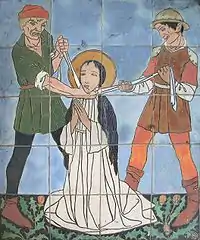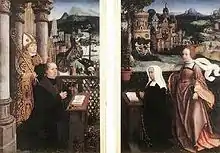Godelieve
Saint Godelieve (also known as Godeleva, Godeliève, and Godelina; Dutch: Sint-Godelieve) (c. 1052[4] – 6 July 1070) is a Flemish saint.[5] She behaved with charity & gentleness to all, accepting an arranged marriage as was the custom, but her husband and family turned out to be abusive. Eventually he had her strangled by his servants. [4]
Godelieve | |
|---|---|
 The Strangulation of Godelina. Image in Procession Chapel in Gistel, Belgium. | |
| Born | c. 1052 |
| Died | 6 July 1070 (aged 17–18) |
| Venerated in | Catholic Church |
| Canonized | 1084[1] by Pope Urban II |
| Feast | 6 July; 30 July |
| Attributes | crown, well, being strangled[2] |
| Patronage | the weather invoked against throat trouble peaceful marriage[3] |
Every year, on the Sunday following 5 July, a procession celebrating Saint Godelieve takes place in Gistel.
Hagiography
Tradition, as recorded in her Vita, states that she was pious as a young girl, and became much sought after by suitors as a beautiful young woman. Godelieve, however, wanted to become a nun. A nobleman named Bertolf (Berthold) of Gistel, however, determined to marry her, successfully invoked the help of her father's overlord, Eustace II, Count of Boulogne, along with her parents. She accepted the betrothal obediently & went to Bertolf's family home. There she was badly treated by him and his mother. She continued to live as an obedient daughter-in-law, managing the household well and with Christian charity. [5] Bertold became more dissatisfied with her, and he ordered his servants to provide only bread and water to the young bride.[4] Godelieve shared this food with the poor.[6]
Godelieve managed to escape to the home of her father, Hemfrid, seigneur of Wierre-Effroy.[5] Hemfrid, appealing to the Bishops of Tournai and Soissons and the Count of Flanders, they concluded the marriage to be indissoluble and managed to have Bertolf restore Godelieve to her rightful position as his wife, which signaled a renewal of persecution.[7]
In July 1070, Godelieve returned to Gistel and soon after, at the order of Bertolf, was strangled by two servants and thrown into a pool,[lower-alpha 1][4] causing it to appear she died a natural death.[7]
Legend
According to legend, Bertolf married again, and had a daughter Edith, who was born blind: the legend states that Edith was cured through the intercession of Saint Godelieve.[8] Bertolf, now repentant of his crimes, went to Rome to obtain absolution. He went on a pilgrimage to the Holy Land, and became a monk at St. Winnoc's Abbey at Bergues.[8] Edith founded a Benedictine monastery at Gistel, which was dedicated to Saint Godelieve, which she joined herself as a nun.[8]
Veneration
Godelieve's body was exhumed in 1084 by the Bishops of Tournai and Noyon, in the presence of Gertrude of Saxony, the wife of Robert I, Count of Flanders, the Abbot of St. Winnoc's and a number of clergymen. It was Radbod II, bishop of Noyon-Tournai, that consecrated Godelieve's relics in 1084,[9] and Godelieve's popular cult developed thereafter.[10]
Drogo, a monk of St. Winnoc's Abbey, wrote Godelieve's biography, the Vita Godeliph, about ten years after her death.[11] The abbey of Ten Putte Abbey in Bruges was dedicated to her.[3]
Every year, on the Sunday following 5 July, a procession celebrating Saint Godelieve takes place in Gistel. In 2017, the Godelieve procession was recognized as an Intangible Cultural Heritage.[12]
Godelieve's feast day, 6 July, was, like that of Saint Swithun in England and Saint Medard in France, connected with the weather. She is thus considered one of the "weather saints".[13] A monastery of Benedictine nuns was established on the site of her home, belonging to the Subiaco Congregation. It was closed due to falling numbers about 2020; the building is currently under review by the city/church authorities.
The Godelieve Polyptych
Godelieve's life is represented in the Godelieve Polyptych, now in the Metropolitan Museum of Art in New York City.[14]
 Donor with Saint Nicholas and Wife with Saint Godelina by Jan Provoost.
Donor with Saint Nicholas and Wife with Saint Godelina by Jan Provoost. Chapel at the back of the Onze-Lieve-Vrouw-ter-Duinenkerk, Ostend, Belgium: stained glass representations of Saint Godelieve and Saint Idesbald.
Chapel at the back of the Onze-Lieve-Vrouw-ter-Duinenkerk, Ostend, Belgium: stained glass representations of Saint Godelieve and Saint Idesbald.
Notes
- Kienzle and Nienhuis state she was placed in her bed[4]
References
- Mulder-Bakker, Anneke B. (2003). The Invention of Saintliness. Routledge. p. 67. ISBN 978-1-134-49865-9.
- Stracke, Richard (20 October 2015). "Saint Godelieve: The Iconography". Christian Iconography.
- de Vries 2007, p. 44.
- Kienzle & Nienhuis 2001, p. 45.
- Harper-Bill 1999, p. 157.
- Kienzle & Nienhuis 2001, p. 50.
- Rudge, F.M. "St. Godelina." The Catholic Encyclopedia Vol. 6. New York: Robert Appleton Company, 1909. 4 October 2021
 This article incorporates text from this source, which is in the public domain.
This article incorporates text from this source, which is in the public domain. - Mulder-Bakker 2002, p. 69.
- Kienzle & Nienhuis 2001, p. 46.
- Kienzle & Nienhuis 2001, p. 45-46.
- Head 2001, p. 359.
- "Godelieve van Gistel | een vrouw van alle tijden". Godelieve van Gistel.
- "Liturgical Year : Activities : Weather Saints". www.catholicculture.org.
- "The Life and Miracles of Saint Godelieve". The Met.
![]() This article incorporates text from a publication now in the public domain: Herbermann, Charles, ed. (1913). "St. Godelina". Catholic Encyclopedia. New York: Robert Appleton Company.
This article incorporates text from a publication now in the public domain: Herbermann, Charles, ed. (1913). "St. Godelina". Catholic Encyclopedia. New York: Robert Appleton Company.
Sources
- de Vries, Andre (2007). Flanders: A Cultural History. Oxford University Press.
- Harper-Bill, Christopher (1999). Anglo-Norman Studies XXI: Proceedings of the Battle Conference 1998. The Boydell Press.
- Head, Thomas F., ed. (2001). Medieval Hagiography: An Anthology. Routledge.
- Kienzle, Beverly Mayne; Nienhuis, Nancy (2001). "Battered Women and the Construction of Sanctity". Journal of Feminist Studies in Religion. 17 (1 Spring).
- Mulder-Bakker, Anneke B., ed. (2002). The Invention of Saintliness. Routledge.
External links
![]() Media related to Saint Godelina at Wikimedia Commons
Media related to Saint Godelina at Wikimedia Commons
- Godeleva (Godelina) von Gistel (in German)
- Santa Godeleva (in Italian)
- Saint Godelieve, Martyr at the Christian Iconography web site